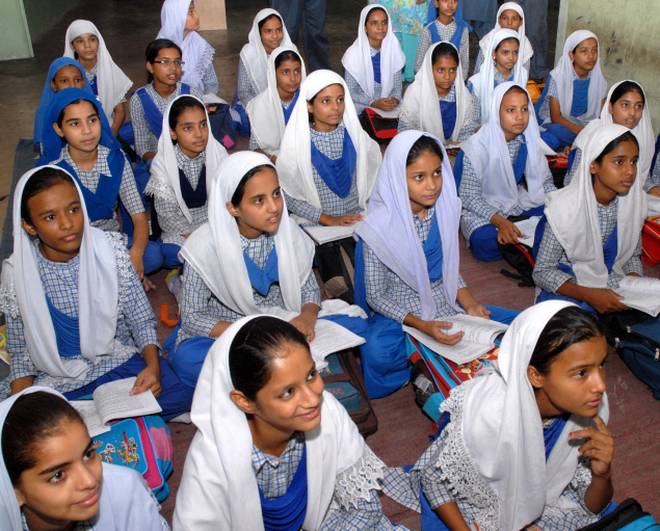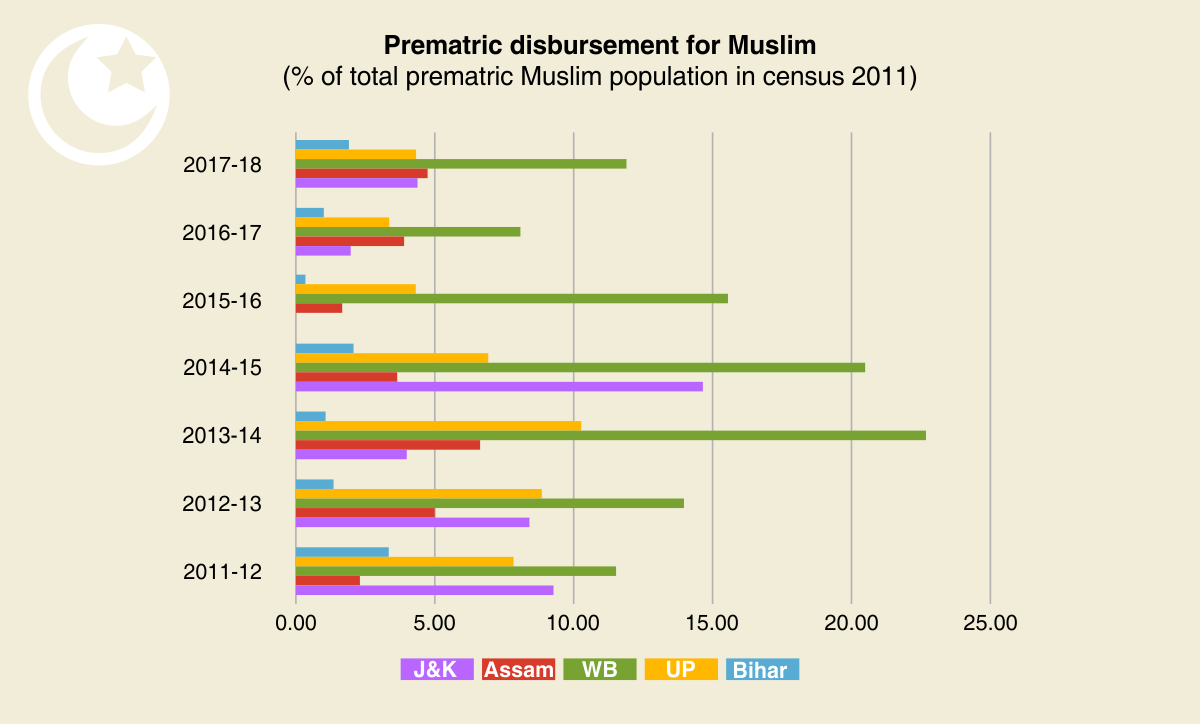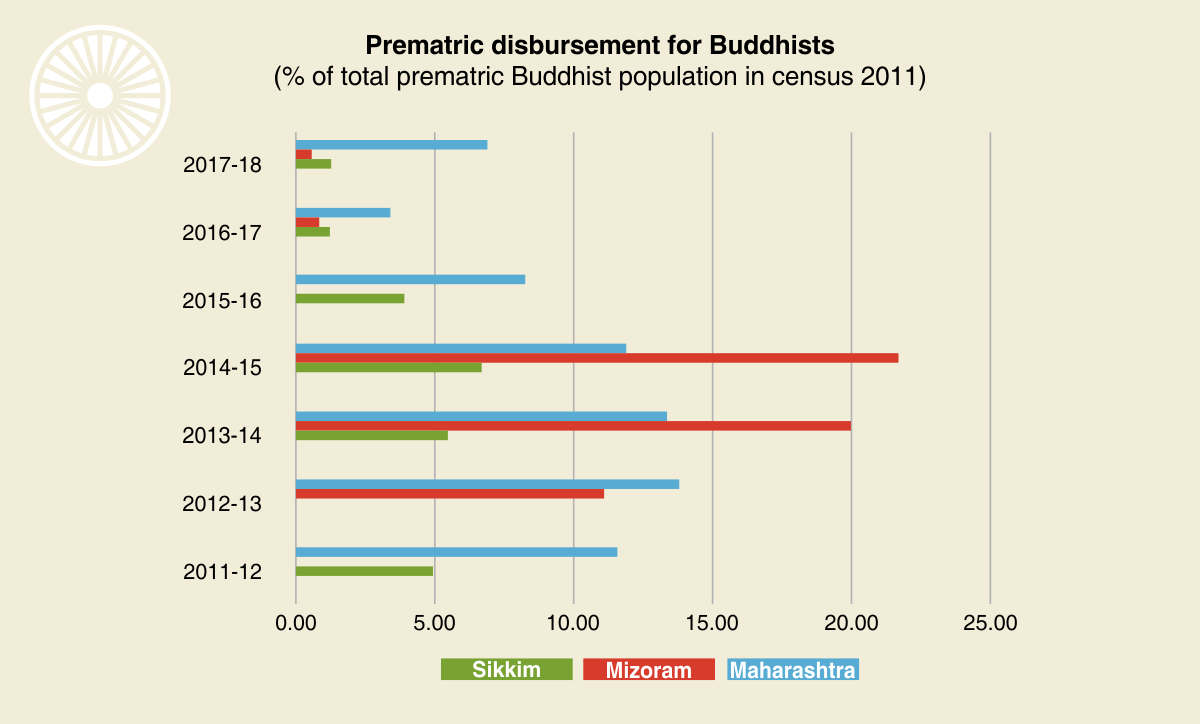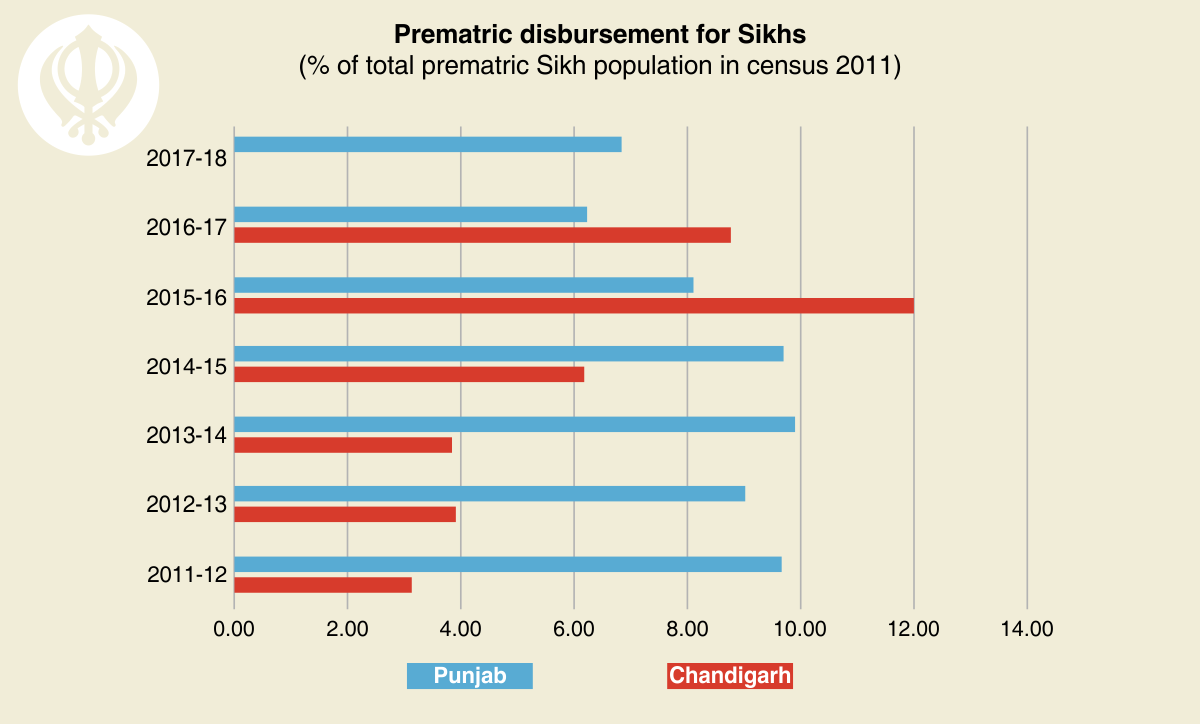AN EXCLUSIVE SABRANG SERIES
A cynical combined ploy of queezing funds from the Sarva Shiksha Abhiyan and overall funds for the Prime Minister’s Minority Scholarship Programme in general, has left India’s minorities, large and small, with a masive decline in scholarships for deserving students

Barely 20% of India’s deserving Buddhist students, enrolled under the PM’s scheme, have been found to be receiving the Pre-matric scholarship (refer graph 2), for Sikhs (refer graph 4) this was even lower at 12%. On the other hand for India’s Muslims and Christians the best coverage is almost 45% and their average coverage is higher than the average coverage of the Buddhist and Sikh communities.
Poverty levels of the minorities in different states have a clear link to absence of access and deliverance of the scholarships.
Jammu and Kashmir (J & K) which has a Muslim majority and Punjab has a Sikh majority. Their 10.35 and 8.26 percentage populations were below the poverty line and the coverage of the scholarship remains less than 15% and 12% respectively.
A similar pattern is observed in the case of Christians too. Majority christian states are Nagaland, Mizoram and Meghalaya which have 18.88, 20.87 and 11.87% populations living below the poverty line. It seems that the relative poverty of minorities has a role to play in the level of coverage that the scholarship is providing.
This excIusive study by Sabrabgindia has found that all the larger minorities namely Muslims, Sikhs and Christians have experienced a decline in the outreach of the scholarships while Buddhists have seen a massive decline in states where their population is significant. This might be due to a dispersed population of Buddhists because they are not a majority in any state though significant in four of them, and it is difficult for them to assert their identity over a state Government.
However, this is not the case with Sikhs and Buddhists. Sikhs are concentrated in Punjab and Chandigarh, where they are a majority in the state. Buddhists are significant in Arunachal Pradesh, Sikkim, Mizoram and Maharashtra. These states have seen a gradual decline in coverage over the 2011-12 to 2017-18 period.
The first part of this exclusive Sabrangindia Series titled “Sab Ka Saath, Sab Ka Vikas a Farce as Direct Transfers Spell Doom for Minority Students. This may be read here.
Contrary to the general rhetoric of appeasing the minority we find that despite these minorities being significant, real basic benefits of equal opportunity are being systematically denied since the very start to them. It is probably the populist demands that are much more effective in winning minority electoral support over, if indeed minority appeasement occurs.
Mindful of these requirements the Prime Minister’s 15 point programme for minorities provides the pre-matric scholarship to minority students.
The pre-matric scholarship scheme has been started to “form the foundation for their educational attainment and provide a level playing field in the competitive employment arena” as it is held that “empowerment through education, which is one of the objectives of this scheme, has the potential to lead to upliftment of the socio economic conditions of the minority communities,” It also earmarks 30% of the beneficiaries to be female children. Although this remains a small percentage of reservation, bearing in mind that the girl child is more likely to be withdrawn from education due to lack of funds in a family. However, it is a progressive beginning which could be extended to reservations to SCs and STs in every religion too.
These percentages also depend upon the level of poverty a community suffers. It might be that say less buddhist households maybe poor and therefore lower applications for scholarship were received and so lower were granted.
The figures for state-wise religious poverty were not available but BPL population in states where these religious minorities are majorities can be considered a proxy of relative wealth of the minority. Buddhists are not a majority in any Indian state, however J&K has a Muslim majority and Punjab has a Sikh majority. Their 10.35 and 8.26 percentage populations were below the poverty line and the coverage of the scholarship remains less than 15% and 12% respectively. The same thing is observed in the case of Christians too. Majority christian states are Nagaland, Mizoram and Meghalaya which have 18.88, 20.87 and 11.87% populations living below the poverty line. It seems that the relative poverty of minorities has a role to play in the level of coverage that the scholarship is providing.
Muslim percentage disbursement in Assam, West Bengal and Uttar Pradesh have a uniform pattern of movement over the period, where they peak in the year 2013-14 and trough in the year 2016-17.
In Buddhist disbursement all three states move in tandem to peak at 2014-15 and trough at 2016-17.
The Christian-dominated states show signs of moving in different patterns but most of them peak at 2014-15 and though Punjab does not see a very pronounced decline, Chandigarh peaks at 2013-14 and begins to slide rapidly thereafter.
The year 2016-17 witnessed a sharp cut in funding as a sum of Rs 584.90 crore was sought to be disbursed marking an over 30% fall over the previous year. While during this year, the number of targeted beneficiaries was again 30 lakh, the number of students actually reached dwindled further to reach 31.14 lakh.The data for the year 2017-18 on state or union territory wise and community wise distribution of the pre-matric scholarship scheme for students belonging to the minority communities revealed that the “community/gender wise data” had not been reconciled.
According to this data the total number of beneficiaries were targeted to be 30 lakh but only about 12% of them or 3,69,549 were actually benefited in the first quarter of the fiscal till June 30, 2017.
The targeted group was supposed to comprise 21.39 lakh Muslims, 3.72 lakh Christians, 2.97 lakh Sikhs, 1.23 lakh Buddhists, 65,448 Jains and 1,030 Parsis. It goes without saying that the losses in terms of number of scholarships were largely commensurate with this ratio. For all the beneficiaries put together, a sum of Rs 63.13 crore was sanctioned. The lofty ideals on which the pre-matric scholarship was started have not been enough to save it from major financial cuts. Contrary to achieving a educational funding of 6% of the GDP as promised by the BJP it has now declined to 3.8%.
The megre increase of 2.2% in the SarvaShikshaAbhiyan over the last year allocation barely compensates for the increase in inflation and thus is doing very little to aid the implementation of the RTE Act. It is not a surprise that India has not met the 2013 and 2015 deadlines of the RTE implementation.
It has also not achieved the Millenium development goal of universal education by 2015. This is just the beginning, if the Government does not recognise the gravity of having a literate population the demographic dividend will fail to contribute to India’s growth. Even the slew of schemes to have smart cities, make in india, skill india and make digital India are bound to crumble at the hands of an illiterate population that stands helplessly alienated.
Graph 1: Muslim Beneficiaries of prematric Scholarship as percentage of total Muslim students enrolled in pre-matric classes, in states with majority or significant Muslim population

Graph 2: Buddhist Beneficiaries of prematric Scholarship as percentage of total Buddhist students enrolled in pre-matric classes, in states with majority or significant Buddhist population

Graph 3: Christian Beneficiaries of prematric Scholarship as percentage of total Christian students enrolled in pre-matric classes, in states with majority or significant Christian population

Notwithstanding the rate of growth or decline in coverage, the level of coverage is generally low. Not even 25% of enrolled minority students are receiving the prematric scholarship, except in Mizoram in one year. However, the coverage is somewhat higher in the larger minorities than the smaller ones. For instance, graph 2 shows us that at best 20% of Buddhists enrolled were receiving the pre-matric scholarship, for sikhs (refer graph 4) this was even lower at 12%. On the other hand for Muslims and Christians the best coverage is almost 45% and their average coverage is higher than the average coverage of Buddhist and Sikh communities.
Graph 4: Sikh Beneficiaries of prematric Scholarship as percentage of total Sikh students enrolled in pre-matric classes, in states with majority or significant Sikh population

Methodology
The pre-matric scholarship is being disbursed under this scheme since 2006 through the ministry of minority affairs to Muslims, Christians, Sikh, Buddhists, Jains and Parsis. To find out the outreach of these scholarships overtime, selected states that the census 2011 earmarks have majority and significant populations of religious minorities were studied. The number of beneficiaries of the scholarship to say Muslims were divided by the number of Muslim children enrolled in schools between the agegroup in the specific state to understand, one in how many students are being benefitted by the scheme.
Background
The RTE Act 2009 ensures the access of free and compulsory education between the age of 6-14years. India is not alone in stressing the importance of nonpartisan access to education, about 135 other countries have constitutional provisions guaranteeing free and non-discriminatory education for all. In 1950, India made a Constitutional commitment to provide free and compulsory education to all children up to the age of 14, by adding this provision in article 45 of the directive principles of state policy. The act postulates, “The Central and the State Governments shall have concurrent responsibility for providing funds for carrying out the provisions of this Act.” This makes it the responsibility of the state and central Government to ensure that elementary education is provided to every child. This implies that special measures for the backward and oppressed sections of the society are imperative. Female students, religious minorities and oppressed castes require elevated assistance to reach the confines of a school.
Despite 71 years since independence, penetration of education in the rural hinterland remains a challenge. Offlate technology is being seen as the facilitator of the last mile connectivity between teachers and students. The larger concern of getting parents to send their children to school has gotten somewhat eclipsed. The mid-day meal scheme served as a great incentive for parents to send their children to school because alongwith education they received much needed nutrition. The 2011 national census of India found the total number of child labourers, aged 5–14, to be at 10.1 million.
This is the alternative fate that numerous Indian children meet outside schools. Given this reality it is imperative that the Government take measures to get parents to enrol their children in schools rather than putting them to work. One of these measures is financial support in the form of scholarships.
Ankita Rastogi is a PhD scholar at Jawaharlal Nehru University, Delhi
Also Read
EXCLUSIVE: Sab Ka Saath, Sab Ka Vikas a Farce, as Direct Benefit Transfers Spell Doom for Minority Students